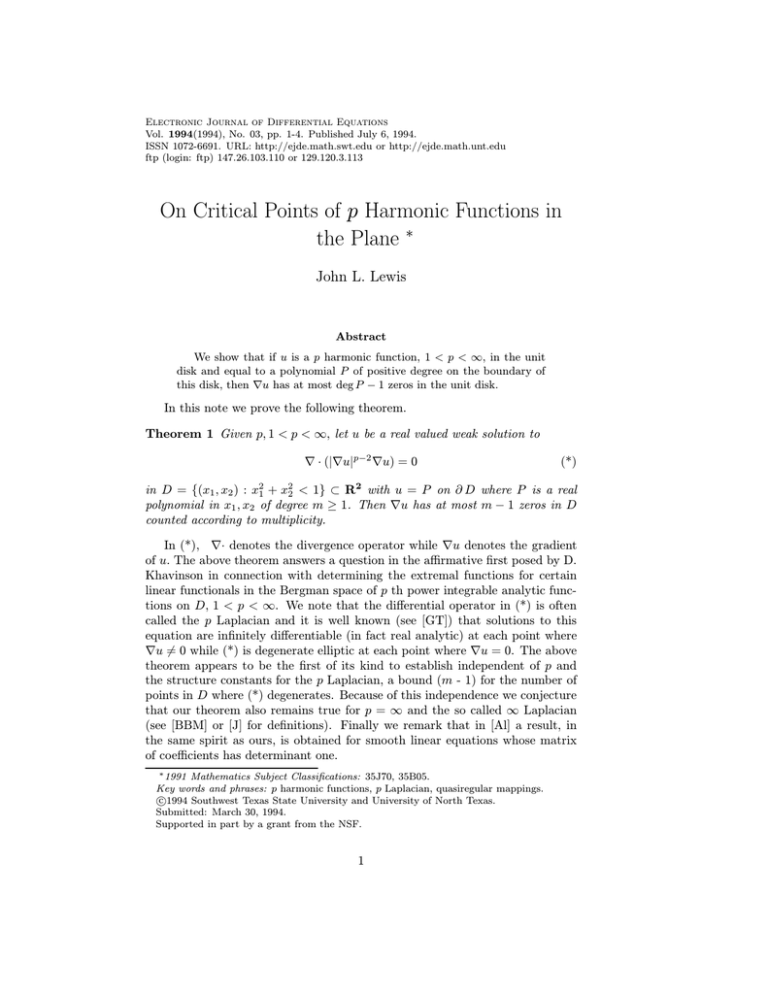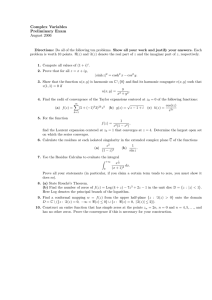Document 10747565
advertisement

Electronic Journal of Differential Equations
Vol. 1994(1994), No. 03, pp. 1-4. Published July 6, 1994.
ISSN 1072-6691. URL: http://ejde.math.swt.edu or http://ejde.math.unt.edu
ftp (login: ftp) 147.26.103.110 or 129.120.3.113
On Critical Points of p Harmonic Functions in
the Plane ∗
John L. Lewis
Abstract
We show that if u is a p harmonic function, 1 < p < ∞, in the unit
disk and equal to a polynomial P of positive degree on the boundary of
this disk, then ∇u has at most deg P − 1 zeros in the unit disk.
In this note we prove the following theorem.
Theorem 1 Given p, 1 < p < ∞, let u be a real valued weak solution to
∇ · (|∇u|p−2 ∇u) = 0
(*)
in D = {(x1 , x2 ) : x21 + x22 < 1} ⊂ R2 with u = P on ∂ D where P is a real
polynomial in x1 , x2 of degree m ≥ 1. Then ∇u has at most m − 1 zeros in D
counted according to multiplicity.
In (*), ∇· denotes the divergence operator while ∇u denotes the gradient
of u. The above theorem answers a question in the affirmative first posed by D.
Khavinson in connection with determining the extremal functions for certain
linear functionals in the Bergman space of p th power integrable analytic functions on D, 1 < p < ∞. We note that the differential operator in (*) is often
called the p Laplacian and it is well known (see [GT]) that solutions to this
equation are infinitely differentiable (in fact real analytic) at each point where
∇u 6= 0 while (*) is degenerate elliptic at each point where ∇u = 0. The above
theorem appears to be the first of its kind to establish independent of p and
the structure constants for the p Laplacian, a bound (m - 1) for the number of
points in D where (*) degenerates. Because of this independence we conjecture
that our theorem also remains true for p = ∞ and the so called ∞ Laplacian
(see [BBM] or [J] for definitions). Finally we remark that in [Al] a result, in
the same spirit as ours, is obtained for smooth linear equations whose matrix
of coefficients has determinant one.
∗ 1991 Mathematics Subject Classifications: 35J70, 35B05.
Key words and phrases: p harmonic functions, p Laplacian, quasiregular mappings.
c
1994
Southwest Texas State University and University of North Texas.
Submitted: March 30, 1994.
Supported in part by a grant from the NSF.
1
2
p HARMONIC FUNCTIONS
EJDE–1994/03
Proof of main theorem.
Consider the strong solutions, v = v(·, , p), to
p
∇ · (( + |∇v|2 ) 2 −1 ∇v) = 0
(**)
in D, with v = P on ∂D. We note that (**) implies
Lv = (p − 2)
2
X
vxj xk vxj vxk + ( + |∇v|2 ) ∆v = 0
(0)
j,k=1
at each point of D. Here ∆ denotes the Laplacian. From (0) and elliptic theory it
follows that v(·, ) is unique and infinitely differentiable in the closed unit disk
(v ∈ C ∞ (D̄)). Indeed this statement follows easily from Schauder’s theorem
(see [GT], ch 6) and induction once C 1,α regularity of v in D̄ is established (
for C 1,α regularity of v see [L]).
√
Next we introduce complex notation. Let z = x1 + ix2 , i = −1, and put
gz = 12 (gx1 − igx2 ), gz̄ = 12 (gx1 + igx2 ). as usual and note from (0) as in [GT,
ch 11, section 2] or [IM], that if f (z) = f (z, , p) = vz (z), then f is quasiregular
in D with k = |1 − 2/p|. That is f is a sense preserving mapping of D and
|fz̄ | ≤ |1 − 2/p| |fz |
(1)
at each point of D. From the factorization theorem for quasiregular mappings
(see [A, ch V ] ) we find that f = g ◦ h where g is analytic in h(D) and h is
a QC mapping of R2 onto itself (i.e. a quasiregular homeomorphism of R2 ).
Using this factorization, the argument principle for analytic functions, and C 1
smoothness of f in D̄, it follows that we can calculate the number of zeros of
f counted according to multiplicity inside a contour Γ ⊂ D̄ with f 6= 0 on Γ
(i.e the number of zeros of g counted according to multiplicity inside h(Γ)) by
calculating
Z
d log f (z(t))
dt
(2)
(2πi)−1
dt
Γ
where log f denotes a continuous branch of the logarithm of f on Γ and we
assume z = z(t) is a piecewise smooth parametrization of Γ . Now we can write
x1 , x2 in terms of z, z̄ in the usual way and thus regard P as a function of z, z̄.
If z = eiθ , θ real, we note first that z̄ = z −1 and second that
Pθ (z) = izPz − iz̄Pz̄
is identically equal to a rational function of degree at most 2m on ∂D. To
construct Γ let zj = eiθj , j = 1, 2, . . . n be the distinct zeros of ∂P
∂θ on ∂D. From
our note we have n ≤ 2m. For small δ > 0 let D(zj , δ) = {z : |z − zj | < δ}
for 1 ≤ j ≤ n. Then for δ small enough, clearly ∂D \ ∪ni=1 D(zj , δ) consists of
n closed arcs, say ∪ni=1 γi , oriented counterclockwise, as seen from the origin.
EJDE–1994/03
J.L. Lewis
3
Let Cj be the arc of ∂D(zj , δ) that lies inside the unit circle for 1 ≤ j ≤ n
oriented counterclockwise as seen from the origin. We put Γ = (∪Cj ) ∪ (∪γj ).
and shall show that the integral in (2) is ≤ m − 1. To this end, let γ ∈ {γj }
and note that if z = eiθ , then Pθ = 2 Re (izvz ). Since Pθ does not change sign
on γ it follows that the image of γ under zf = zvz lies inside a halfplane whose
boundary contains 0. Thus a continuous argument of zf can change by at most
π on γ and so
Z
d log[z(t)f (z(t))]
Re (2πi)−1
≤ 1/2.
dt
(3)
dt
γ
Next we consider Ck ∈ {Cj }. Recall that v ∈ C ∞ (D̄). If vz (zk ) 6= 0 then
clearly
Z
d log[z(t)f (z(t))] (2πi)−1
dt → 0
(4)
dt
Ck
as δ → 0. Otherwise, let l > 1 be the largest positive integer such that all
homogeneous Taylor polynomials of v − v(zk ) about zk of degree less than l are
identically 0 and let Q be the homogeneous Taylor polynomial of degree l about
zk corresponding to v − v(zk ). Using (0) and continuity of the derivatives of v
in D̄ we see that for z ∈ D ∩ D(zk , δ)
0 = Lv(z) = O(|z − zk |3l−4 ) + ∆Q(z)
(5)
as z → zk , Now ∆Q is either a homogeneous polynomial of degree l −2 or ∆Q ≡
0. Dividing (5) by |z − zk |l−2 and taking a limit as z → zk we conclude that the
second possibility must occur. Thus Q is harmonic and so Q = Re [c(z − zk )l ]
for some complex c. From this fact we conclude first that for a continuous
branch of log f on Ck we have
log(izf (z)) = log[izQz (z)] + o(1), as δ → 0 for z ∈ Ck ,
where the o(1) term is independent of z ∈ Ck . Second we conclude
Z
d log[z(t)f (z(t))]
(2πi)−1
dt → −(l − 1)/2
dt
Ck
(6)
as δ → 0. Since the integral in (2) must be a nonnegative integer we see from
(3) and (6) that for δ sufficiently small
Z
d log[f (z(t))]
−1
(2πi)
dt ≤ m − 1
(7)
dt
Γ
since there are at most 2m members of {γj } and the argument of z changes by
2π as we go around Γ.
Finally, v, vz considered as functions of converge uniformly on compact
subsets of D to u, uz , for a fixed p as → 0. These facts follow from the
4
p HARMONIC FUNCTIONS
EJDE–1994/03
uniqueness of u as a solution to the p Laplacian and C 1,α regularity of u, v
(with constants independent of ). Moreover from (1) it follows that uz is
quasiregular in D with k = |1 − 2/p| (again see [IM] for these facts). From these
observations, (7), and another winding number argument we find that if uz 6= 0
on {z : |z| = r} for some r, 0 < r < 1, then uz has at most m − 1 zeros in
{z : |z| < r}. Hence our theorem is true. 2
References
[A]
L.V. Ahlfors, Quasiconformal Mappings, Van Nostrand Company,
Princeton, New Jersey, 1966.
[Al]
G. Alessandrini,Critical points of solutions of elliptic equations in two
variables, Ann. Scuola Norm. Sup. Pisa Cl. Sci. 4 14(1987), 229-256.
[BBM] T. Bhattacharya, E. DiBenedetto, and J. Manfredi, Limits as p → ∞
of ∆p up = f and related extremal problems, Rend. Sem. Mat. Univ.
Pol. torino, Fascicolo Speciale (1989) Nonlinear PDE’s, 15-68.
[GT]
D. Gilbarg and N. Trudinger, Elliptic partial differential equations of
second order, Springer Verlag, New York, 1977.
[IM]
T. Iwaniec and J. Manfredi, Regularity of p harmonic functions on the
plane, Revista Matematica Iberoamericana 5 (1989), 1-19.
[J]
R. Jensen, Uniqueness of Lipschitz extensions: minimizing the sup
norm of the gradient, Arch. Rational Mech. Anal 123 (1993), 51-74.
[ L]
G. M. Lieberman, Boundary regularity for solutions of degenerate elliptic equations, Nonlinear Anal. 12 (1988), 1203-1219.
John L Lewis
Department of Mathematics, University of Kentucky, Lexington,
Kentucky 40506-0027
E-mail address: john@ms.uky.edu




